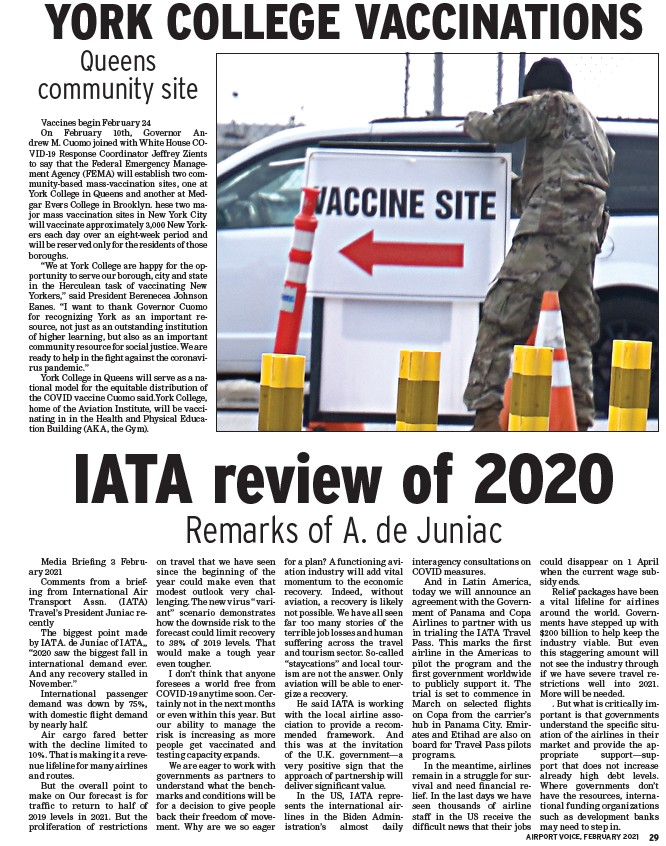
YORK COLLEGE VACCINATIONS
AIRPORT VOICE, FEBRUARY 2021 29
Queens
community site
Vaccines begin February 24
On February 10th, Governor An‑drew
M. Cuomo joined with White House CO‑VID‑19
Response Coordinator Jeffrey Zients
to say that the Federal Emergency Manage‑ment
Agency (FEMA) will establish two com‑munity
based mass-vaccination sites, one at
York College in Queens and another at Med‑gar
Evers College in Brooklyn. hese two ma‑jor
mass vaccination sites in New York City
will vaccinate approximately 3,000 New York‑ers
each day over an eight-week period and
will be reserved only for the residents of those
boroughs.
“We at York College are happy for the op‑portunity
to serve our borough, city and state
in the Herculean task of vaccinating New
Yorkers,” said President Berenecea Johnson
Eanes. “I want to thank Governor Cuomo
for recognizing York as an important re‑source,
not just as an outstanding institution
of higher learning, but also as an important
community resource for social justice. We are
ready to help in the fight against the coronavi‑rus
pandemic.”
York College in Queens will serve as a na‑tional
model for the equitable distribution of
the COVID vaccine Cuomo said.York College,
home of the Aviation Institute, will be vacci‑nating
in in the Health and Physical Educa‑tion
Building (AKA, the Gym).
IATA review of 2020
Remarks of A. de Juniac
Media Briefing 3 Febru‑ary
2021
Comments from a brief‑ing
from International Air
Transport Assn. (IATA)
Travel’s President Juniac re‑cently
The biggest point made
by IATA. de Juniac of IATA,,
“2020 saw the biggest fall in
international demand ever.
And any recovery stalled in
November.”
International passenger
demand was down by 75%,
with domestic flight demand
by nearly half.
Air cargo fared better
with the decline limited to
10%. That is making it a reve‑nue
lifeline for many airlines
and routes.
But the overall point to
make on Our forecast is for
traffic to return to half of
2019 levels in 2021. But the
proliferation of restrictions
on travel that we have seen
since the beginning of the
year could make even that
modest outlook very chal‑lenging.
The new virus “vari‑ant”
scenario demonstrates
how the downside risk to the
forecast could limit recovery
to 38% of 2019 levels. That
would make a tough year
even tougher.
I don’t think that anyone
foresees a world free from
COVID-19 anytime soon. Cer‑tainly
not in the next months
or even within this year. But
our ability to manage the
risk is increasing as more
people get vaccinated and
testing capacity expands.
We are eager to work with
governments as partners to
understand what the bench‑marks
and conditions will be
for a decision to give people
back their freedom of move‑ment.
Why are we so eager
for a plan? A functioning avi‑ation
industry will add vital
momentum to the economic
recovery. Indeed, without
aviation, a recovery is likely
not possible. We have all seen
far too many stories of the
terrible job losses and human
suffering across the travel
and tourism sector. So-called
“staycations” and local tour‑ism
are not the answer. Only
aviation will be able to ener‑gize
a recovery.
He said IATA is working
with the local airline asso‑ciation
to provide a recom‑mended
framework. And
this was at the invitation
of the U.K. government—a
very positive sign that the
approach of partnership will
deliver significant value.
In the US, IATA repre‑sents
the international air‑lines
in the Biden Admin‑istration’s
almost daily
interagency consultations on
COVID measures.
And in Latin America,
today we will announce an
agreement with the Govern‑ment
of Panama and Copa
Airlines to partner with us
in trialing the IATA Travel
Pass. This marks the first
airline in the Americas to
pilot the program and the
first government worldwide
to publicly support it. The
trial is set to commence in
March on selected flights
on Copa from the carrier’s
hub in Panama City. Emir‑ates
and Etihad are also on
board for Travel Pass pilots
programs.
In the meantime, airlines
remain in a struggle for sur‑vival
and need financial re‑lief.
In the last days we have
seen thousands of airline
staff in the US receive the
difficult news that their jobs
could disappear on 1 April
when the current wage sub‑sidy
ends.
Relief packages have been
a vital lifeline for airlines
around the world. Govern‑ments
have stepped up with
$200 billion to help keep the
industry viable. But even
this staggering amount will
not see the industry through
if we have severe travel re‑strictions
well into 2021.
More will be needed.
. But what is critically im‑portant
is that governments
understand the specific situ‑ation
of the airlines in their
market and provide the ap‑propriate
support—sup‑port
that does not increase
already high debt levels.
Where governments don’t
have the resources, interna‑tional
funding organizations
such as development banks
may need to step in.